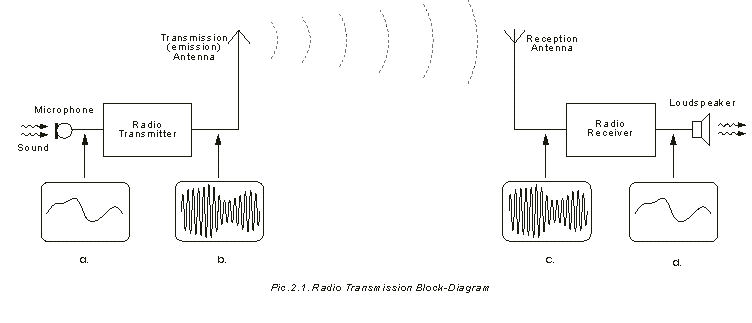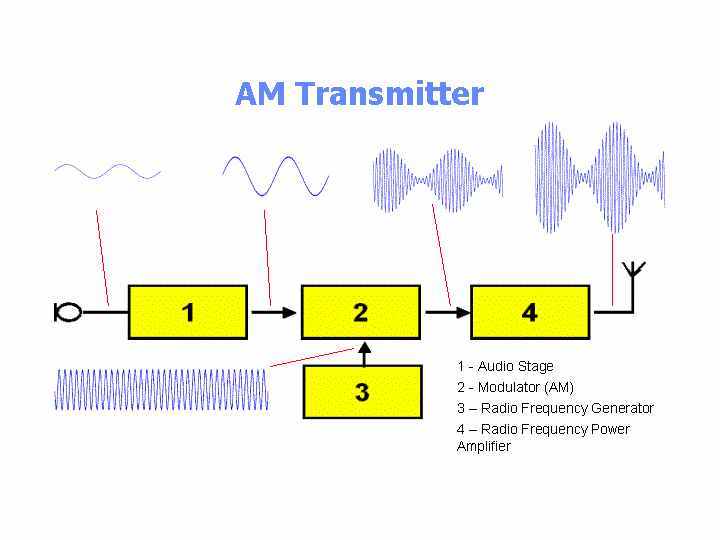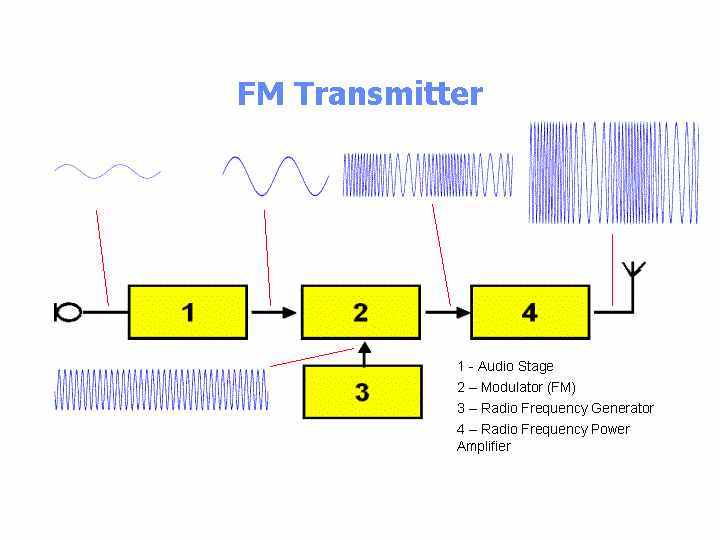Difference between revisions of "Radio"
| Line 39: | Line 39: | ||
==Modulation, demodulation== | ==Modulation, demodulation== | ||
| + | |||
| + | |||
| + | [[File:Radio-receiver-transmitter-block-diagram.gif]] | ||
| + | |||
| + | The above image shows a schematic representation of what happens in a radio transmission. From left to right: Sound enters the microphone of the transmitting radio, the microphone converts the sound into small voltages (a). These voltages are then fed into the transmitter where they are used to modulate the carrier wave of the transmitter. This modulation is a combining of two signals, a very fast carrier wave which is slightly altered by the slower audio wave. This modulated carrier wave (b) is then emitted via the antenna. On the receiving end the emission is picked up by the antenna (because it is tuned to carrier waves of that frequency). In the receiver the carrier wave (c) is substracted from the incoming signal in a process called demodulation, leaving only the small voltages of the audio(d). These are in turn used to drive the speaker, which turns them in to small pressure waves that create sound we can hear. | ||
| + | |||
| + | |||
| + | === AM === | ||
| + | [[File:AM-transmitter-block-diagram.jpeg]] | ||
| + | |||
| + | A schematic representation of '''A'''mplitude '''M'''odulation. From left to right: an audio signal enters and is amplified (stage 1). That signal is used to modulate (stage 2) the carrier wave generated by the oscillator (stage 3). The modulation happens by using the input signal to slightly increase the strength (or amplitude) of the carrier wave. This amplitude modulated signal is then sent to an amplifier (further increasing the amplitude of the wave, thus the power) before being emitted by the antenna. | ||
| + | |||
| + | |||
| + | === FM === | ||
| + | |||
| + | [[File:FM-transmitter-block-diagram.jpg]] | ||
| + | |||
| + | |||
| + | |||
| + | A schematic representation of '''F'''requency '''M'''odulation. From left to right: an audio signal enters and is amplified (stage 1). That signal is used to modulate (stage 2) the carrier wave generated by the oscillator (stage 3). The modulation happens by using the input signal to slightly change the speed (or frequency) of the carrier wave. This frequency modulated signal is then sent to an amplifier (further increasing the amplitude of the wave, thus the power) before being emitted by the antenna. | ||
| + | |||
| + | |||
| + | === MG (Mesmerizing Gif) === | ||
| + | |||
| + | http://4.bp.blogspot.com/-XrdWN4hz4U4/VdD972wtYCI/AAAAAAAAAUU/7a8PMLvTOV4/s1600/Modulation%2BGif.gif | ||
| + | |||
| + | Have a look at the mesmerizing gif above where we see how the same Modulator + Carrier results in different wave forms (but containing the same information!) when modulated over amplitude or frequency. | ||
Revision as of 10:29, 26 September 2016
Contents
What is radio?
Radio is a set of technologies and techniques that enables people to use of a specific part of the electromagnetic spectrum to carry information. The use of radio dates back to the late 19th century and is now so ubiquitous that one doesn't even consider it. However it can be considered one of the fundamental infrastructures of our contemporary 'information' society. You might know the word from 'FM Radio' but it is much wider than that. Radio is used in every electronic device that doesn't use wires to communicatie. From babyfoon to cellphone, from remote controlled toy car to wireless car keys, from wi-fi to walkie talkie.
The anatomy of a (radio) wave
Radio signals are composed of fluctuations in electromagnetic fields that are described mathematically as 'waves'. This fluctuation is called an 'oscillation', which describes the up and down movement of the wave. The oscillation of the wave happens at different speeds or frequencies, determining the size of the wave and its on the electromagnetic spectrum. Usually the frequency is expressed in Hertz, after the guy who first described the phenomena. One Herz (Hz) equals one oscillation per second. One Mega Herz (MHz) equals 1,000,000 oscillations per second. The vertical size of the wave is called the amplitude, which relates to the amount of energy the wave has.
From the frequency one can also derive the wavelength (λ), by looking at the distance travelled between each oscillation. Electromagnetic waves travel at the speed of light (300 000 000 meter / second). That means that a one Herz (one oscillation) wave is 300 000 000 meters long and a 100Mhz wave is 3 meter long. The wavelength can be calculated as follows: λ = v/f Where v equals the speed ( in the case of EM waves, the speed of light) and f equals the frequency.
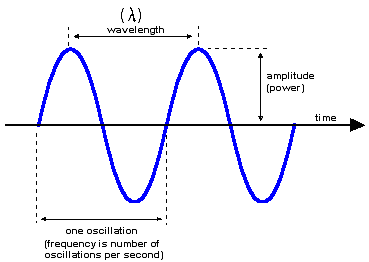
To recap:
Oscillation (up and down movement of the wave) Frequency (amount of oscillations, expressed in Hertz) Hertz (oscillations per second) Amplitude (power of the wave, relate to the amount of energy) Wavelength (λ, distance between each oscillation)
This way to describe waves can be used for any kind of wave, from waves in the ocean to basket balls bouncing, to sound.
Lets listen to an increasingly faster oscillating audio wave, If anyone thinks the amplitude is to high, please let me know.
The electromagnetic spectrum organised by nature
The various types of EM waves, their length etc
The electromagnetic spectrum organised by humans
US Radio Spectrum Allocation Chart
Modulation, demodulation
The above image shows a schematic representation of what happens in a radio transmission. From left to right: Sound enters the microphone of the transmitting radio, the microphone converts the sound into small voltages (a). These voltages are then fed into the transmitter where they are used to modulate the carrier wave of the transmitter. This modulation is a combining of two signals, a very fast carrier wave which is slightly altered by the slower audio wave. This modulated carrier wave (b) is then emitted via the antenna. On the receiving end the emission is picked up by the antenna (because it is tuned to carrier waves of that frequency). In the receiver the carrier wave (c) is substracted from the incoming signal in a process called demodulation, leaving only the small voltages of the audio(d). These are in turn used to drive the speaker, which turns them in to small pressure waves that create sound we can hear.
AM
A schematic representation of Amplitude Modulation. From left to right: an audio signal enters and is amplified (stage 1). That signal is used to modulate (stage 2) the carrier wave generated by the oscillator (stage 3). The modulation happens by using the input signal to slightly increase the strength (or amplitude) of the carrier wave. This amplitude modulated signal is then sent to an amplifier (further increasing the amplitude of the wave, thus the power) before being emitted by the antenna.
FM
A schematic representation of Frequency Modulation. From left to right: an audio signal enters and is amplified (stage 1). That signal is used to modulate (stage 2) the carrier wave generated by the oscillator (stage 3). The modulation happens by using the input signal to slightly change the speed (or frequency) of the carrier wave. This frequency modulated signal is then sent to an amplifier (further increasing the amplitude of the wave, thus the power) before being emitted by the antenna.
MG (Mesmerizing Gif)
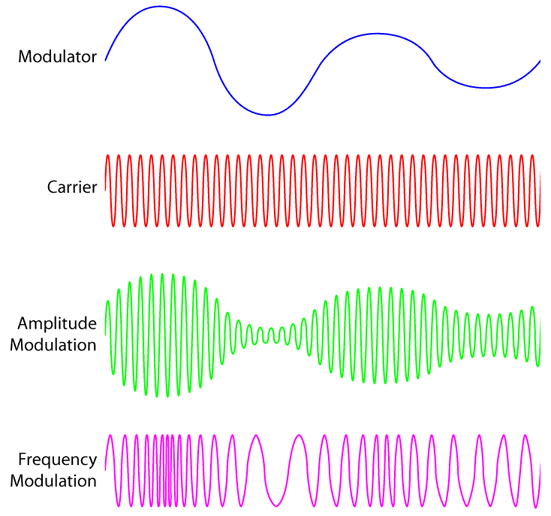
Have a look at the mesmerizing gif above where we see how the same Modulator + Carrier results in different wave forms (but containing the same information!) when modulated over amplitude or frequency.
